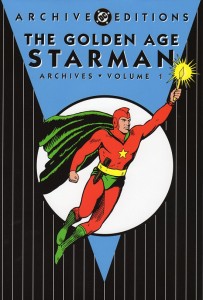Comic Book Review: The Golden Age Starman Archives Volume 1 Written by Gardner Fox; Art by Jack Burnley
Wealthy playboy Ted Knight has somehow harnessed the cosmic energy of the stars in his Gravity Rod. As the world moves to war, he decides that the best use of this technology is to become a costumed superhero, taking the name Starman.
Like many characters created during the Golden Age, Starman did not have an origin story as such, (Roy Thomas gave him one decades later); in the first story Ted Knight has already been operating as Starman long enough to have convinced FBI chief agent Woodley Allen to trust him and for his fiancee Doris Lee to be used to his excuses for slipping away. According to Jack Burnley’s introduction to this volume, this first story was not written by Gardner Fox, and is the only one he substantially revised, inserting a villain he named Dr. Doom (and editorial changed for unknown reasons to Dr. Doog.)
The story itself opens with America in a panic as electrical components suddenly heat up, causing electrical outages, fires and explosions. The FBI is called in on the case and Agent Allen decides this is a job for the Starman. Bored playboy Ted Knight is having dinner with his fiancee Doris Lee in Gotham, one of the unaffected areas when the rod in his pocket starts vibrating. He claims not to be feeling well, but Doris opts to stay for the food she ordered while Ted leaves. A blackout happens, which makes it even easier for Mr. Knight to switch to his Starman outfit.
Conferring with Agent Allen in a cabin outside the city, Starman is informed that the Secret Brotherhood of the Electron is behind the attacks. The FBI can’t locate them, however, as their communications and transportation have been wrecked by the Brotherhood’s electrical control device. Starman’s Gravity Rod is immune to outside control, and can trace the energy to its source in a mountain stronghold.
Inside the stronghold, most of the Brotherhood is ordinary criminals, but Dr. Doog has stolen the Ultra-Dynamo from a Dr. Davis by means of his hypnotic powers. Starman’s rod protects him from hypnosis, and Doog apparently perishes in one of his own death traps. Starman seals the mountain just to make sure.
The stories tended to be formulaic, but reasonably entertaining individually. Starman’s most frequent foe was The Light, a mad scientist who had been laughed out of the scientific community, and developed a shrinking ray (which gives off a hot bright light) to get his revenge. He returned twice, each time with a different scheme. The most iconic villain, however, was the Mist, an elderly man whose head appeared to be floating on a moving cloud. He’d developed an invisibility formula for use in World War One, but been turned down by the government for unknown reasons. Having perfected it, he turned to crime.
The most out-there villain was Cuthbert Cain, a sallow, puny-looking fellow who had combined an advanced knowledge of photo-electric energy and black magic; he could capture the will of anyone he photographed. The story also had one of the best covers of the series on Adventure Comics #66.
Jack Burnley had been a sports cartoonist before going into comic books, and had a style well-suited to the superhero genre, with dynamic poses and framing. But Starman never broke out as a major character. Part of this, I think, is that Ted Knight wasn’t a very compelling character. This hypochondriac made Clark Kent look like a dynamic man of action, and was so dismissive of Doris Lee that at one point the writer makes her explain that he’s much more likable off camera, thus her continuing to put up with him.
As Starman, Ted is fairly generic–his inability to use his powers during the daytime did add some suspense, but the combination of square-jawed virtue and battle wisecracks was shared with over half of the other costumed characters being published at the time.
There’s some period ethnic stereotyping. This may have been the inspiration for Roy Thomas making Starman particularly anti-Japanese in his All-Star Squadron series.
At the time this compilation was published, a modern Starman series featuring Ted’s son Jack Knight was being run with creator James Robinson. I highly recommend it.
As for this book, the art is good, the writing is decent, and it has rare stories. Recommended to Golden Age fans, those who enjoyed the Robinson series, and people who have a good library near them.

